Business Management Report: Motivation, Leadership, and ALDI
VerifiedAdded on 2020/12/18
|12
|3764
|315
Report
AI Summary
This report delves into the realm of business management, focusing on motivation theories and leadership styles within the context of a retail environment, specifically ALDI. It begins by exploring various motivation theories, including Maslow's hierarchy of needs and Vroom's expectancy theory, and their practical application in a business organization. The report then transitions to a comparative analysis of management and leadership styles, highlighting their distinct roles and functions in achieving organizational goals. Furthermore, the report emphasizes the importance of democratic leadership in fostering a positive and productive work environment. Through this comprehensive examination, the report provides valuable insights into effective management practices and their impact on employee performance and overall business success, using ALDI as a practical example.
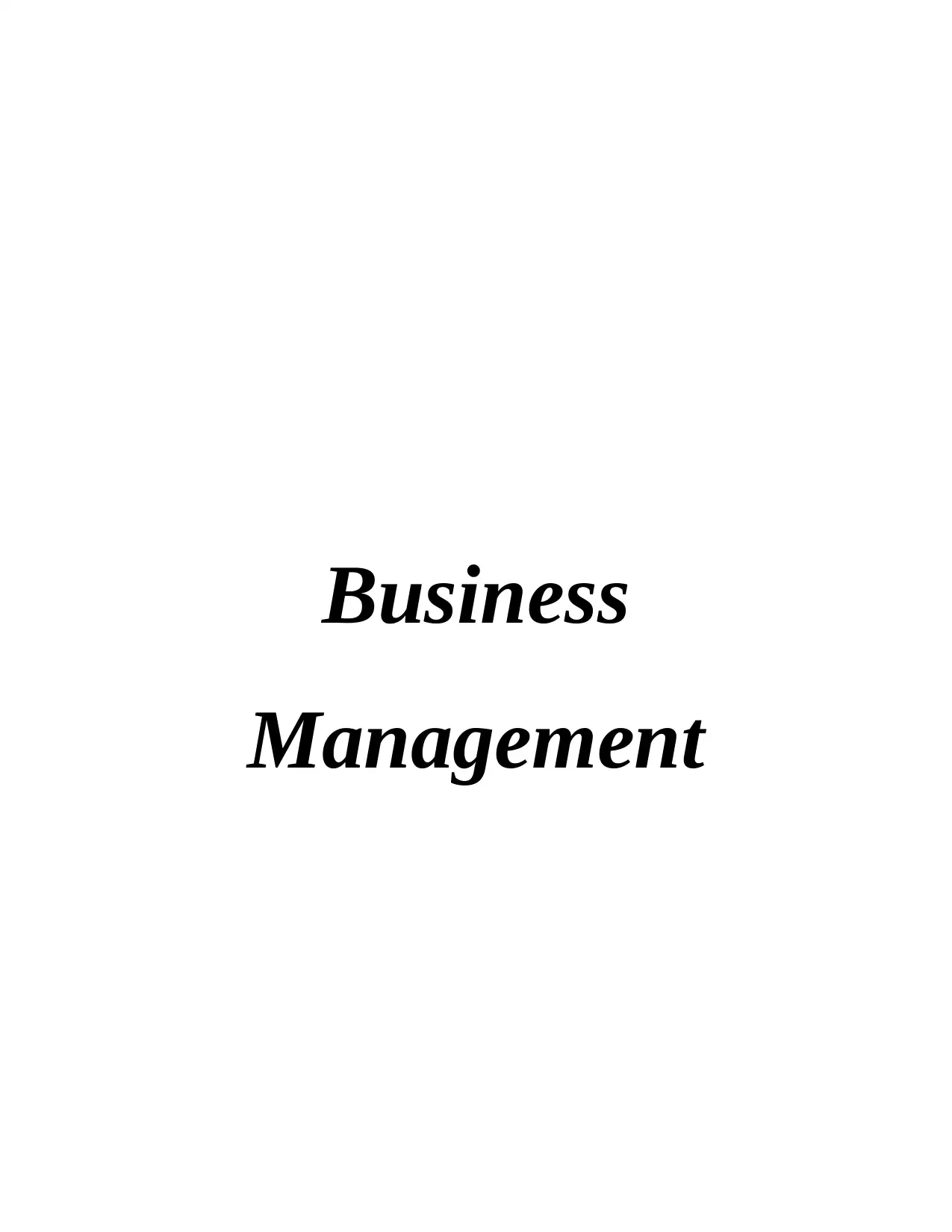
Business
Management
Management
Paraphrase This Document
Need a fresh take? Get an instant paraphrase of this document with our AI Paraphraser
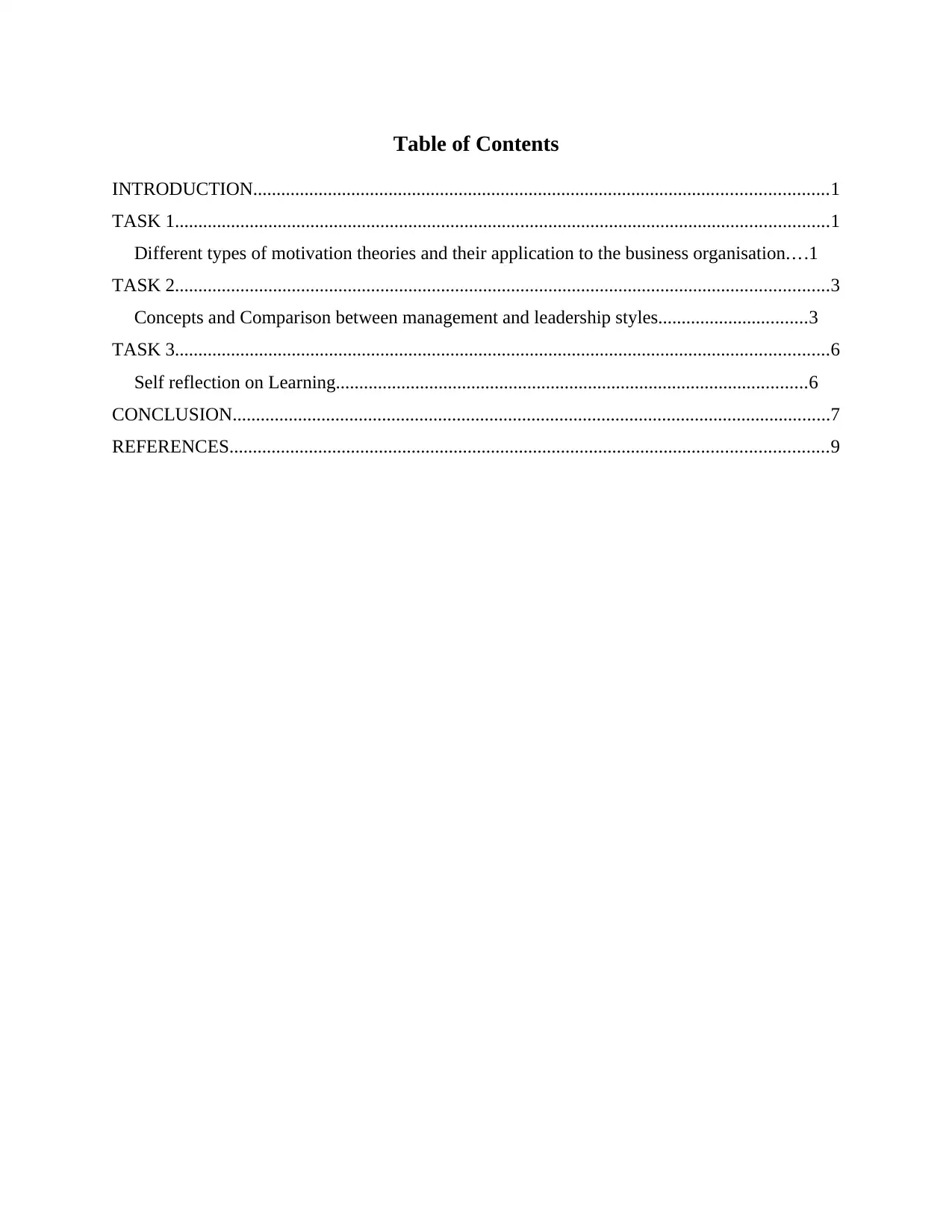
Table of Contents
INTRODUCTION...........................................................................................................................1
TASK 1............................................................................................................................................1
Different types of motivation theories and their application to the business organisation....1
TASK 2............................................................................................................................................3
Concepts and Comparison between management and leadership styles................................3
TASK 3............................................................................................................................................6
Self reflection on Learning.....................................................................................................6
CONCLUSION................................................................................................................................7
REFERENCES................................................................................................................................9
INTRODUCTION...........................................................................................................................1
TASK 1............................................................................................................................................1
Different types of motivation theories and their application to the business organisation....1
TASK 2............................................................................................................................................3
Concepts and Comparison between management and leadership styles................................3
TASK 3............................................................................................................................................6
Self reflection on Learning.....................................................................................................6
CONCLUSION................................................................................................................................7
REFERENCES................................................................................................................................9
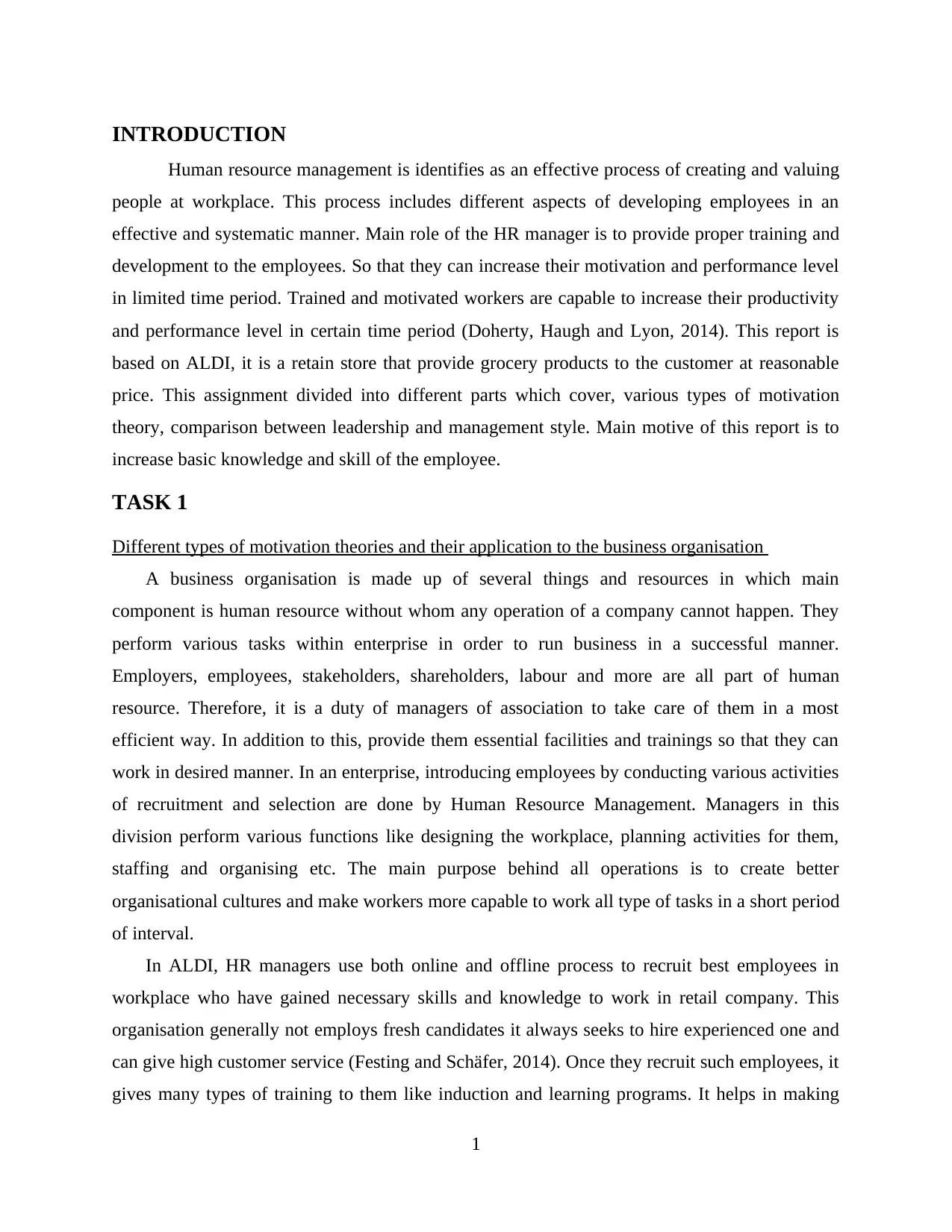
INTRODUCTION
Human resource management is identifies as an effective process of creating and valuing
people at workplace. This process includes different aspects of developing employees in an
effective and systematic manner. Main role of the HR manager is to provide proper training and
development to the employees. So that they can increase their motivation and performance level
in limited time period. Trained and motivated workers are capable to increase their productivity
and performance level in certain time period (Doherty, Haugh and Lyon, 2014). This report is
based on ALDI, it is a retain store that provide grocery products to the customer at reasonable
price. This assignment divided into different parts which cover, various types of motivation
theory, comparison between leadership and management style. Main motive of this report is to
increase basic knowledge and skill of the employee.
TASK 1
Different types of motivation theories and their application to the business organisation
A business organisation is made up of several things and resources in which main
component is human resource without whom any operation of a company cannot happen. They
perform various tasks within enterprise in order to run business in a successful manner.
Employers, employees, stakeholders, shareholders, labour and more are all part of human
resource. Therefore, it is a duty of managers of association to take care of them in a most
efficient way. In addition to this, provide them essential facilities and trainings so that they can
work in desired manner. In an enterprise, introducing employees by conducting various activities
of recruitment and selection are done by Human Resource Management. Managers in this
division perform various functions like designing the workplace, planning activities for them,
staffing and organising etc. The main purpose behind all operations is to create better
organisational cultures and make workers more capable to work all type of tasks in a short period
of interval.
In ALDI, HR managers use both online and offline process to recruit best employees in
workplace who have gained necessary skills and knowledge to work in retail company. This
organisation generally not employs fresh candidates it always seeks to hire experienced one and
can give high customer service (Festing and Schäfer, 2014). Once they recruit such employees, it
gives many types of training to them like induction and learning programs. It helps in making
1
Human resource management is identifies as an effective process of creating and valuing
people at workplace. This process includes different aspects of developing employees in an
effective and systematic manner. Main role of the HR manager is to provide proper training and
development to the employees. So that they can increase their motivation and performance level
in limited time period. Trained and motivated workers are capable to increase their productivity
and performance level in certain time period (Doherty, Haugh and Lyon, 2014). This report is
based on ALDI, it is a retain store that provide grocery products to the customer at reasonable
price. This assignment divided into different parts which cover, various types of motivation
theory, comparison between leadership and management style. Main motive of this report is to
increase basic knowledge and skill of the employee.
TASK 1
Different types of motivation theories and their application to the business organisation
A business organisation is made up of several things and resources in which main
component is human resource without whom any operation of a company cannot happen. They
perform various tasks within enterprise in order to run business in a successful manner.
Employers, employees, stakeholders, shareholders, labour and more are all part of human
resource. Therefore, it is a duty of managers of association to take care of them in a most
efficient way. In addition to this, provide them essential facilities and trainings so that they can
work in desired manner. In an enterprise, introducing employees by conducting various activities
of recruitment and selection are done by Human Resource Management. Managers in this
division perform various functions like designing the workplace, planning activities for them,
staffing and organising etc. The main purpose behind all operations is to create better
organisational cultures and make workers more capable to work all type of tasks in a short period
of interval.
In ALDI, HR managers use both online and offline process to recruit best employees in
workplace who have gained necessary skills and knowledge to work in retail company. This
organisation generally not employs fresh candidates it always seeks to hire experienced one and
can give high customer service (Festing and Schäfer, 2014). Once they recruit such employees, it
gives many types of training to them like induction and learning programs. It helps in making
1
⊘ This is a preview!⊘
Do you want full access?
Subscribe today to unlock all pages.

Trusted by 1+ million students worldwide
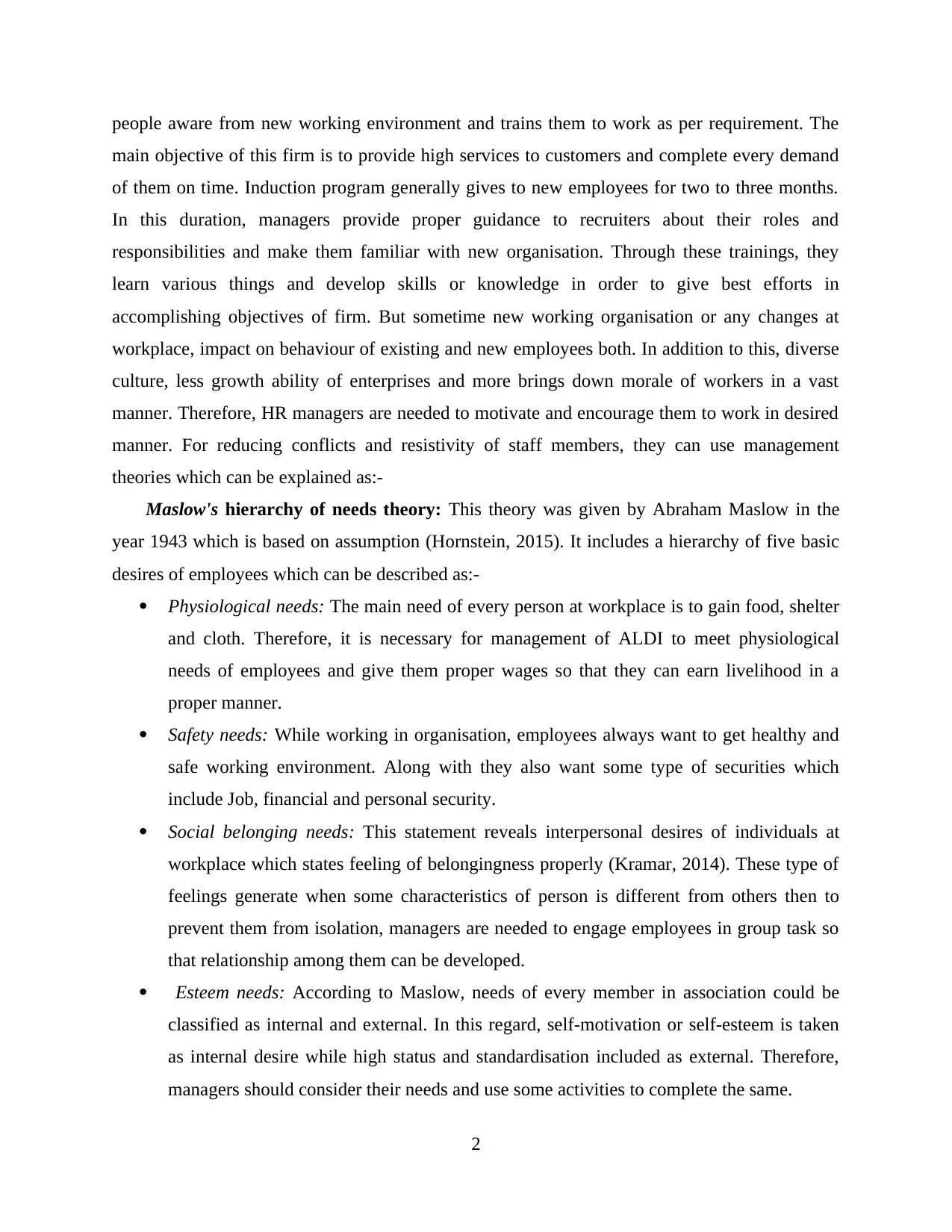
people aware from new working environment and trains them to work as per requirement. The
main objective of this firm is to provide high services to customers and complete every demand
of them on time. Induction program generally gives to new employees for two to three months.
In this duration, managers provide proper guidance to recruiters about their roles and
responsibilities and make them familiar with new organisation. Through these trainings, they
learn various things and develop skills or knowledge in order to give best efforts in
accomplishing objectives of firm. But sometime new working organisation or any changes at
workplace, impact on behaviour of existing and new employees both. In addition to this, diverse
culture, less growth ability of enterprises and more brings down morale of workers in a vast
manner. Therefore, HR managers are needed to motivate and encourage them to work in desired
manner. For reducing conflicts and resistivity of staff members, they can use management
theories which can be explained as:-
Maslow's hierarchy of needs theory: This theory was given by Abraham Maslow in the
year 1943 which is based on assumption (Hornstein, 2015). It includes a hierarchy of five basic
desires of employees which can be described as:-
Physiological needs: The main need of every person at workplace is to gain food, shelter
and cloth. Therefore, it is necessary for management of ALDI to meet physiological
needs of employees and give them proper wages so that they can earn livelihood in a
proper manner.
Safety needs: While working in organisation, employees always want to get healthy and
safe working environment. Along with they also want some type of securities which
include Job, financial and personal security.
Social belonging needs: This statement reveals interpersonal desires of individuals at
workplace which states feeling of belongingness properly (Kramar, 2014). These type of
feelings generate when some characteristics of person is different from others then to
prevent them from isolation, managers are needed to engage employees in group task so
that relationship among them can be developed.
Esteem needs: According to Maslow, needs of every member in association could be
classified as internal and external. In this regard, self-motivation or self-esteem is taken
as internal desire while high status and standardisation included as external. Therefore,
managers should consider their needs and use some activities to complete the same.
2
main objective of this firm is to provide high services to customers and complete every demand
of them on time. Induction program generally gives to new employees for two to three months.
In this duration, managers provide proper guidance to recruiters about their roles and
responsibilities and make them familiar with new organisation. Through these trainings, they
learn various things and develop skills or knowledge in order to give best efforts in
accomplishing objectives of firm. But sometime new working organisation or any changes at
workplace, impact on behaviour of existing and new employees both. In addition to this, diverse
culture, less growth ability of enterprises and more brings down morale of workers in a vast
manner. Therefore, HR managers are needed to motivate and encourage them to work in desired
manner. For reducing conflicts and resistivity of staff members, they can use management
theories which can be explained as:-
Maslow's hierarchy of needs theory: This theory was given by Abraham Maslow in the
year 1943 which is based on assumption (Hornstein, 2015). It includes a hierarchy of five basic
desires of employees which can be described as:-
Physiological needs: The main need of every person at workplace is to gain food, shelter
and cloth. Therefore, it is necessary for management of ALDI to meet physiological
needs of employees and give them proper wages so that they can earn livelihood in a
proper manner.
Safety needs: While working in organisation, employees always want to get healthy and
safe working environment. Along with they also want some type of securities which
include Job, financial and personal security.
Social belonging needs: This statement reveals interpersonal desires of individuals at
workplace which states feeling of belongingness properly (Kramar, 2014). These type of
feelings generate when some characteristics of person is different from others then to
prevent them from isolation, managers are needed to engage employees in group task so
that relationship among them can be developed.
Esteem needs: According to Maslow, needs of every member in association could be
classified as internal and external. In this regard, self-motivation or self-esteem is taken
as internal desire while high status and standardisation included as external. Therefore,
managers should consider their needs and use some activities to complete the same.
2
Paraphrase This Document
Need a fresh take? Get an instant paraphrase of this document with our AI Paraphraser
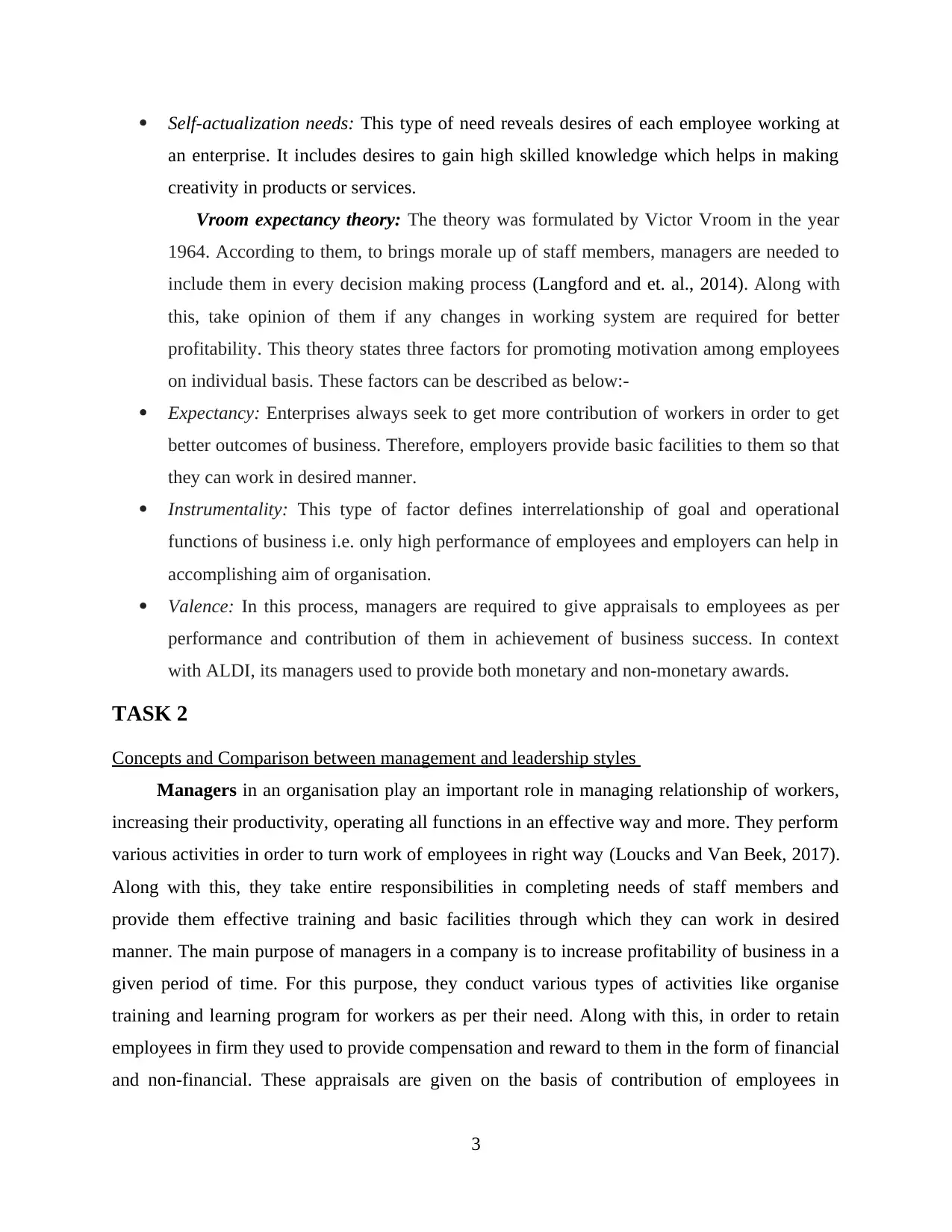
Self-actualization needs: This type of need reveals desires of each employee working at
an enterprise. It includes desires to gain high skilled knowledge which helps in making
creativity in products or services.
Vroom expectancy theory: The theory was formulated by Victor Vroom in the year
1964. According to them, to brings morale up of staff members, managers are needed to
include them in every decision making process (Langford and et. al., 2014). Along with
this, take opinion of them if any changes in working system are required for better
profitability. This theory states three factors for promoting motivation among employees
on individual basis. These factors can be described as below:-
Expectancy: Enterprises always seek to get more contribution of workers in order to get
better outcomes of business. Therefore, employers provide basic facilities to them so that
they can work in desired manner.
Instrumentality: This type of factor defines interrelationship of goal and operational
functions of business i.e. only high performance of employees and employers can help in
accomplishing aim of organisation.
Valence: In this process, managers are required to give appraisals to employees as per
performance and contribution of them in achievement of business success. In context
with ALDI, its managers used to provide both monetary and non-monetary awards.
TASK 2
Concepts and Comparison between management and leadership styles
Managers in an organisation play an important role in managing relationship of workers,
increasing their productivity, operating all functions in an effective way and more. They perform
various activities in order to turn work of employees in right way (Loucks and Van Beek, 2017).
Along with this, they take entire responsibilities in completing needs of staff members and
provide them effective training and basic facilities through which they can work in desired
manner. The main purpose of managers in a company is to increase profitability of business in a
given period of time. For this purpose, they conduct various types of activities like organise
training and learning program for workers as per their need. Along with this, in order to retain
employees in firm they used to provide compensation and reward to them in the form of financial
and non-financial. These appraisals are given on the basis of contribution of employees in
3
an enterprise. It includes desires to gain high skilled knowledge which helps in making
creativity in products or services.
Vroom expectancy theory: The theory was formulated by Victor Vroom in the year
1964. According to them, to brings morale up of staff members, managers are needed to
include them in every decision making process (Langford and et. al., 2014). Along with
this, take opinion of them if any changes in working system are required for better
profitability. This theory states three factors for promoting motivation among employees
on individual basis. These factors can be described as below:-
Expectancy: Enterprises always seek to get more contribution of workers in order to get
better outcomes of business. Therefore, employers provide basic facilities to them so that
they can work in desired manner.
Instrumentality: This type of factor defines interrelationship of goal and operational
functions of business i.e. only high performance of employees and employers can help in
accomplishing aim of organisation.
Valence: In this process, managers are required to give appraisals to employees as per
performance and contribution of them in achievement of business success. In context
with ALDI, its managers used to provide both monetary and non-monetary awards.
TASK 2
Concepts and Comparison between management and leadership styles
Managers in an organisation play an important role in managing relationship of workers,
increasing their productivity, operating all functions in an effective way and more. They perform
various activities in order to turn work of employees in right way (Loucks and Van Beek, 2017).
Along with this, they take entire responsibilities in completing needs of staff members and
provide them effective training and basic facilities through which they can work in desired
manner. The main purpose of managers in a company is to increase profitability of business in a
given period of time. For this purpose, they conduct various types of activities like organise
training and learning program for workers as per their need. Along with this, in order to retain
employees in firm they used to provide compensation and reward to them in the form of financial
and non-financial. These appraisals are given on the basis of contribution of employees in
3
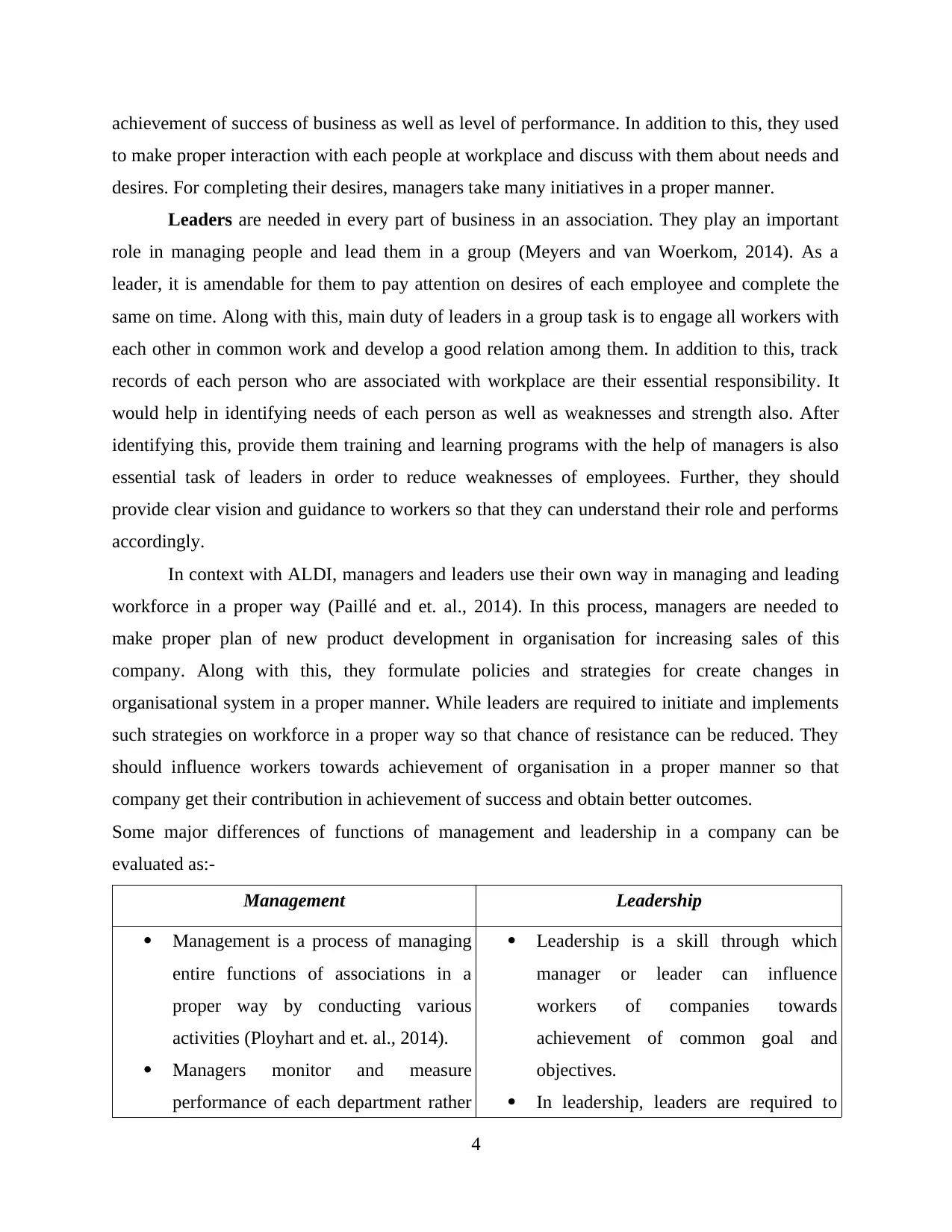
achievement of success of business as well as level of performance. In addition to this, they used
to make proper interaction with each people at workplace and discuss with them about needs and
desires. For completing their desires, managers take many initiatives in a proper manner.
Leaders are needed in every part of business in an association. They play an important
role in managing people and lead them in a group (Meyers and van Woerkom, 2014). As a
leader, it is amendable for them to pay attention on desires of each employee and complete the
same on time. Along with this, main duty of leaders in a group task is to engage all workers with
each other in common work and develop a good relation among them. In addition to this, track
records of each person who are associated with workplace are their essential responsibility. It
would help in identifying needs of each person as well as weaknesses and strength also. After
identifying this, provide them training and learning programs with the help of managers is also
essential task of leaders in order to reduce weaknesses of employees. Further, they should
provide clear vision and guidance to workers so that they can understand their role and performs
accordingly.
In context with ALDI, managers and leaders use their own way in managing and leading
workforce in a proper way (Paillé and et. al., 2014). In this process, managers are needed to
make proper plan of new product development in organisation for increasing sales of this
company. Along with this, they formulate policies and strategies for create changes in
organisational system in a proper manner. While leaders are required to initiate and implements
such strategies on workforce in a proper way so that chance of resistance can be reduced. They
should influence workers towards achievement of organisation in a proper manner so that
company get their contribution in achievement of success and obtain better outcomes.
Some major differences of functions of management and leadership in a company can be
evaluated as:-
Management Leadership
Management is a process of managing
entire functions of associations in a
proper way by conducting various
activities (Ployhart and et. al., 2014).
Managers monitor and measure
performance of each department rather
Leadership is a skill through which
manager or leader can influence
workers of companies towards
achievement of common goal and
objectives.
In leadership, leaders are required to
4
to make proper interaction with each people at workplace and discuss with them about needs and
desires. For completing their desires, managers take many initiatives in a proper manner.
Leaders are needed in every part of business in an association. They play an important
role in managing people and lead them in a group (Meyers and van Woerkom, 2014). As a
leader, it is amendable for them to pay attention on desires of each employee and complete the
same on time. Along with this, main duty of leaders in a group task is to engage all workers with
each other in common work and develop a good relation among them. In addition to this, track
records of each person who are associated with workplace are their essential responsibility. It
would help in identifying needs of each person as well as weaknesses and strength also. After
identifying this, provide them training and learning programs with the help of managers is also
essential task of leaders in order to reduce weaknesses of employees. Further, they should
provide clear vision and guidance to workers so that they can understand their role and performs
accordingly.
In context with ALDI, managers and leaders use their own way in managing and leading
workforce in a proper way (Paillé and et. al., 2014). In this process, managers are needed to
make proper plan of new product development in organisation for increasing sales of this
company. Along with this, they formulate policies and strategies for create changes in
organisational system in a proper manner. While leaders are required to initiate and implements
such strategies on workforce in a proper way so that chance of resistance can be reduced. They
should influence workers towards achievement of organisation in a proper manner so that
company get their contribution in achievement of success and obtain better outcomes.
Some major differences of functions of management and leadership in a company can be
evaluated as:-
Management Leadership
Management is a process of managing
entire functions of associations in a
proper way by conducting various
activities (Ployhart and et. al., 2014).
Managers monitor and measure
performance of each department rather
Leadership is a skill through which
manager or leader can influence
workers of companies towards
achievement of common goal and
objectives.
In leadership, leaders are required to
4
⊘ This is a preview!⊘
Do you want full access?
Subscribe today to unlock all pages.

Trusted by 1+ million students worldwide
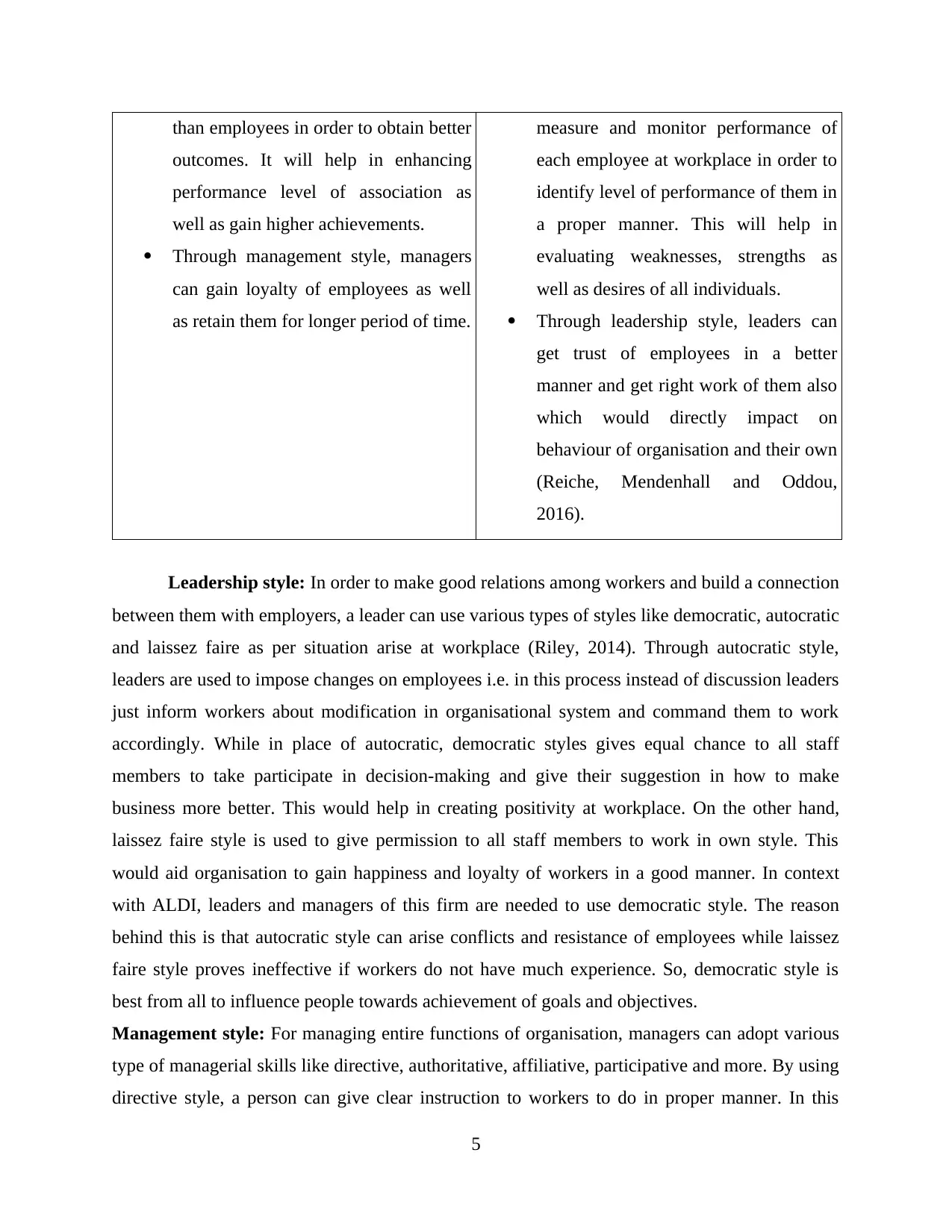
than employees in order to obtain better
outcomes. It will help in enhancing
performance level of association as
well as gain higher achievements.
Through management style, managers
can gain loyalty of employees as well
as retain them for longer period of time.
measure and monitor performance of
each employee at workplace in order to
identify level of performance of them in
a proper manner. This will help in
evaluating weaknesses, strengths as
well as desires of all individuals.
Through leadership style, leaders can
get trust of employees in a better
manner and get right work of them also
which would directly impact on
behaviour of organisation and their own
(Reiche, Mendenhall and Oddou,
2016).
Leadership style: In order to make good relations among workers and build a connection
between them with employers, a leader can use various types of styles like democratic, autocratic
and laissez faire as per situation arise at workplace (Riley, 2014). Through autocratic style,
leaders are used to impose changes on employees i.e. in this process instead of discussion leaders
just inform workers about modification in organisational system and command them to work
accordingly. While in place of autocratic, democratic styles gives equal chance to all staff
members to take participate in decision-making and give their suggestion in how to make
business more better. This would help in creating positivity at workplace. On the other hand,
laissez faire style is used to give permission to all staff members to work in own style. This
would aid organisation to gain happiness and loyalty of workers in a good manner. In context
with ALDI, leaders and managers of this firm are needed to use democratic style. The reason
behind this is that autocratic style can arise conflicts and resistance of employees while laissez
faire style proves ineffective if workers do not have much experience. So, democratic style is
best from all to influence people towards achievement of goals and objectives.
Management style: For managing entire functions of organisation, managers can adopt various
type of managerial skills like directive, authoritative, affiliative, participative and more. By using
directive style, a person can give clear instruction to workers to do in proper manner. In this
5
outcomes. It will help in enhancing
performance level of association as
well as gain higher achievements.
Through management style, managers
can gain loyalty of employees as well
as retain them for longer period of time.
measure and monitor performance of
each employee at workplace in order to
identify level of performance of them in
a proper manner. This will help in
evaluating weaknesses, strengths as
well as desires of all individuals.
Through leadership style, leaders can
get trust of employees in a better
manner and get right work of them also
which would directly impact on
behaviour of organisation and their own
(Reiche, Mendenhall and Oddou,
2016).
Leadership style: In order to make good relations among workers and build a connection
between them with employers, a leader can use various types of styles like democratic, autocratic
and laissez faire as per situation arise at workplace (Riley, 2014). Through autocratic style,
leaders are used to impose changes on employees i.e. in this process instead of discussion leaders
just inform workers about modification in organisational system and command them to work
accordingly. While in place of autocratic, democratic styles gives equal chance to all staff
members to take participate in decision-making and give their suggestion in how to make
business more better. This would help in creating positivity at workplace. On the other hand,
laissez faire style is used to give permission to all staff members to work in own style. This
would aid organisation to gain happiness and loyalty of workers in a good manner. In context
with ALDI, leaders and managers of this firm are needed to use democratic style. The reason
behind this is that autocratic style can arise conflicts and resistance of employees while laissez
faire style proves ineffective if workers do not have much experience. So, democratic style is
best from all to influence people towards achievement of goals and objectives.
Management style: For managing entire functions of organisation, managers can adopt various
type of managerial skills like directive, authoritative, affiliative, participative and more. By using
directive style, a person can give clear instruction to workers to do in proper manner. In this
5
Paraphrase This Document
Need a fresh take? Get an instant paraphrase of this document with our AI Paraphraser
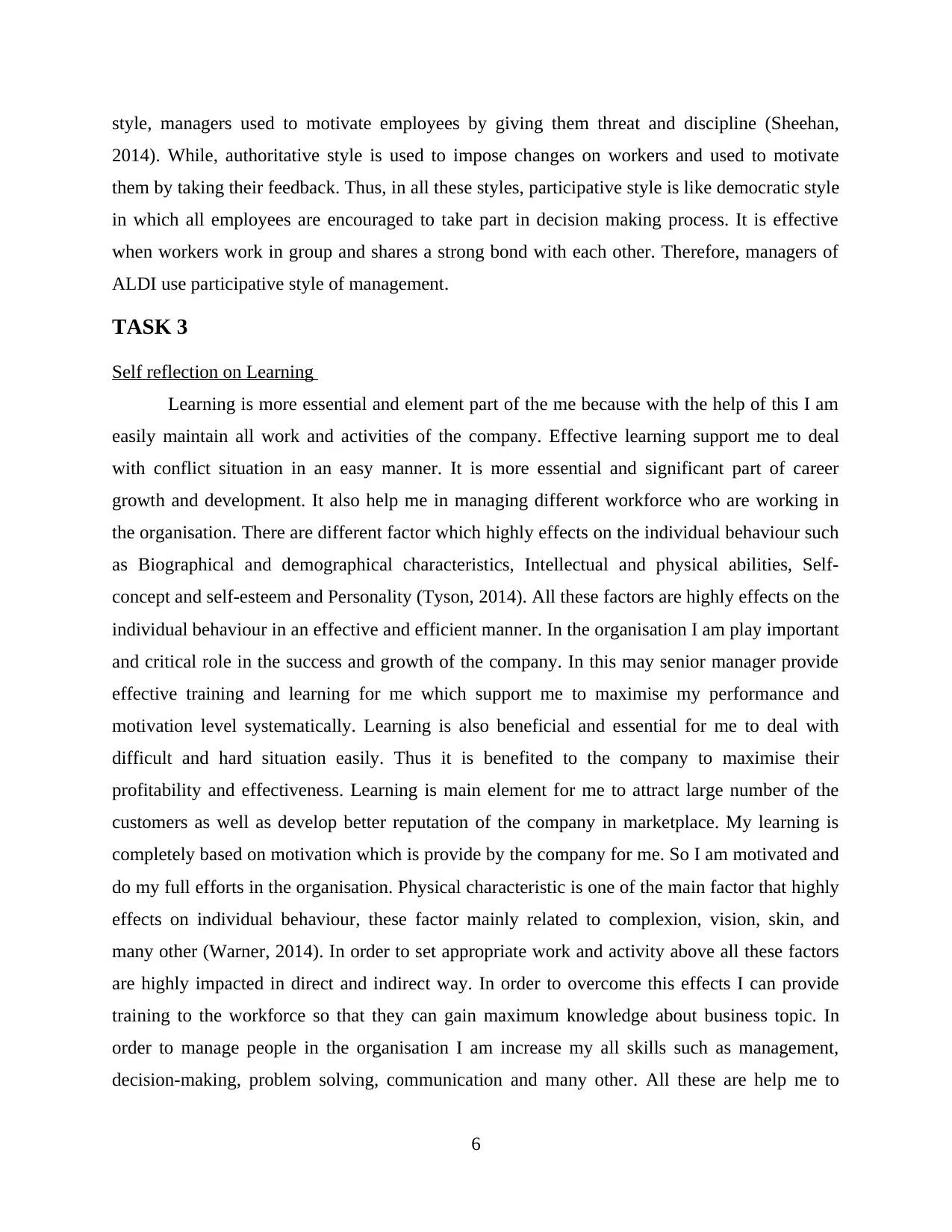
style, managers used to motivate employees by giving them threat and discipline (Sheehan,
2014). While, authoritative style is used to impose changes on workers and used to motivate
them by taking their feedback. Thus, in all these styles, participative style is like democratic style
in which all employees are encouraged to take part in decision making process. It is effective
when workers work in group and shares a strong bond with each other. Therefore, managers of
ALDI use participative style of management.
TASK 3
Self reflection on Learning
Learning is more essential and element part of the me because with the help of this I am
easily maintain all work and activities of the company. Effective learning support me to deal
with conflict situation in an easy manner. It is more essential and significant part of career
growth and development. It also help me in managing different workforce who are working in
the organisation. There are different factor which highly effects on the individual behaviour such
as Biographical and demographical characteristics, Intellectual and physical abilities, Self-
concept and self-esteem and Personality (Tyson, 2014). All these factors are highly effects on the
individual behaviour in an effective and efficient manner. In the organisation I am play important
and critical role in the success and growth of the company. In this may senior manager provide
effective training and learning for me which support me to maximise my performance and
motivation level systematically. Learning is also beneficial and essential for me to deal with
difficult and hard situation easily. Thus it is benefited to the company to maximise their
profitability and effectiveness. Learning is main element for me to attract large number of the
customers as well as develop better reputation of the company in marketplace. My learning is
completely based on motivation which is provide by the company for me. So I am motivated and
do my full efforts in the organisation. Physical characteristic is one of the main factor that highly
effects on individual behaviour, these factor mainly related to complexion, vision, skin, and
many other (Warner, 2014). In order to set appropriate work and activity above all these factors
are highly impacted in direct and indirect way. In order to overcome this effects I can provide
training to the workforce so that they can gain maximum knowledge about business topic. In
order to manage people in the organisation I am increase my all skills such as management,
decision-making, problem solving, communication and many other. All these are help me to
6
2014). While, authoritative style is used to impose changes on workers and used to motivate
them by taking their feedback. Thus, in all these styles, participative style is like democratic style
in which all employees are encouraged to take part in decision making process. It is effective
when workers work in group and shares a strong bond with each other. Therefore, managers of
ALDI use participative style of management.
TASK 3
Self reflection on Learning
Learning is more essential and element part of the me because with the help of this I am
easily maintain all work and activities of the company. Effective learning support me to deal
with conflict situation in an easy manner. It is more essential and significant part of career
growth and development. It also help me in managing different workforce who are working in
the organisation. There are different factor which highly effects on the individual behaviour such
as Biographical and demographical characteristics, Intellectual and physical abilities, Self-
concept and self-esteem and Personality (Tyson, 2014). All these factors are highly effects on the
individual behaviour in an effective and efficient manner. In the organisation I am play important
and critical role in the success and growth of the company. In this may senior manager provide
effective training and learning for me which support me to maximise my performance and
motivation level systematically. Learning is also beneficial and essential for me to deal with
difficult and hard situation easily. Thus it is benefited to the company to maximise their
profitability and effectiveness. Learning is main element for me to attract large number of the
customers as well as develop better reputation of the company in marketplace. My learning is
completely based on motivation which is provide by the company for me. So I am motivated and
do my full efforts in the organisation. Physical characteristic is one of the main factor that highly
effects on individual behaviour, these factor mainly related to complexion, vision, skin, and
many other (Warner, 2014). In order to set appropriate work and activity above all these factors
are highly impacted in direct and indirect way. In order to overcome this effects I can provide
training to the workforce so that they can gain maximum knowledge about business topic. In
order to manage people in the organisation I am increase my all skills such as management,
decision-making, problem solving, communication and many other. All these are help me to
6
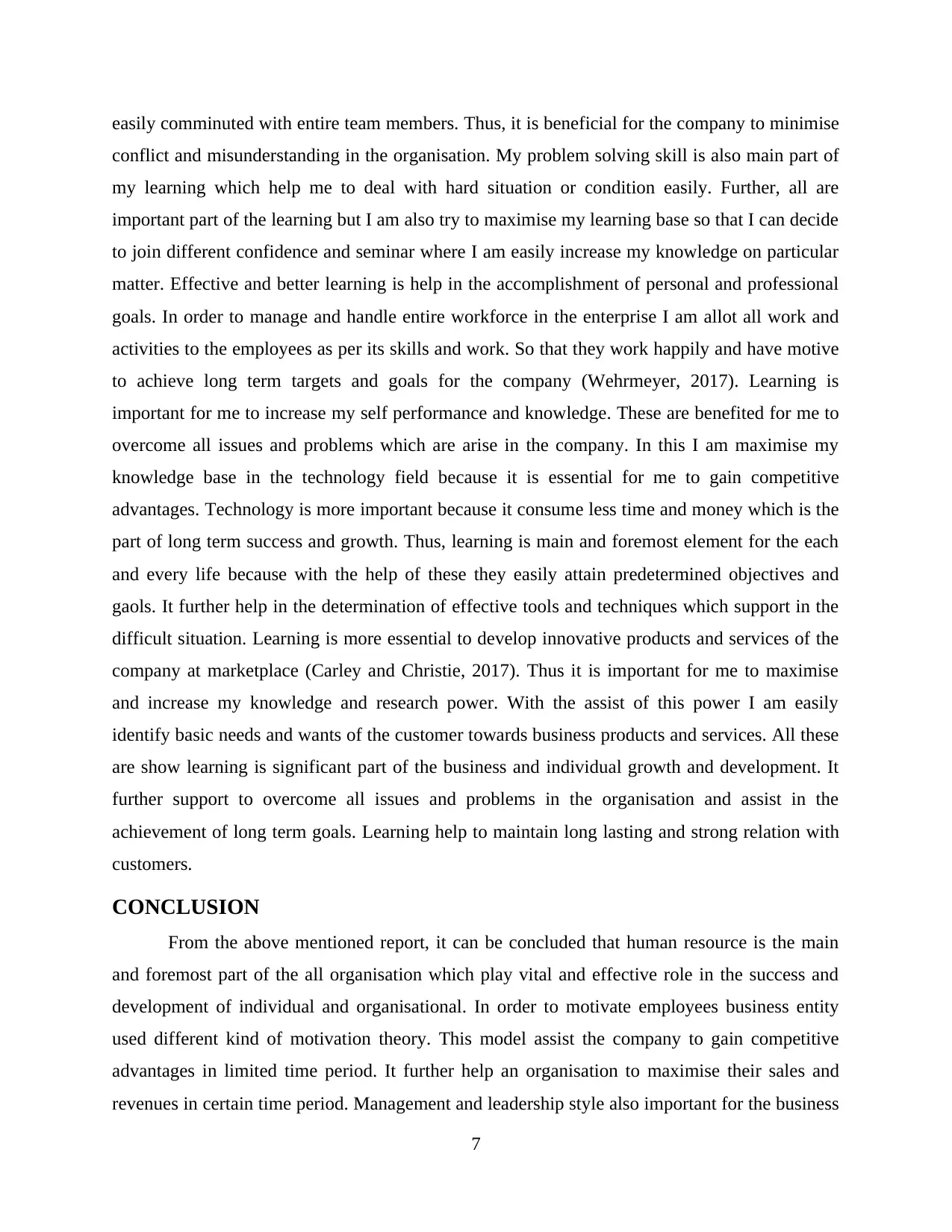
easily comminuted with entire team members. Thus, it is beneficial for the company to minimise
conflict and misunderstanding in the organisation. My problem solving skill is also main part of
my learning which help me to deal with hard situation or condition easily. Further, all are
important part of the learning but I am also try to maximise my learning base so that I can decide
to join different confidence and seminar where I am easily increase my knowledge on particular
matter. Effective and better learning is help in the accomplishment of personal and professional
goals. In order to manage and handle entire workforce in the enterprise I am allot all work and
activities to the employees as per its skills and work. So that they work happily and have motive
to achieve long term targets and goals for the company (Wehrmeyer, 2017). Learning is
important for me to increase my self performance and knowledge. These are benefited for me to
overcome all issues and problems which are arise in the company. In this I am maximise my
knowledge base in the technology field because it is essential for me to gain competitive
advantages. Technology is more important because it consume less time and money which is the
part of long term success and growth. Thus, learning is main and foremost element for the each
and every life because with the help of these they easily attain predetermined objectives and
gaols. It further help in the determination of effective tools and techniques which support in the
difficult situation. Learning is more essential to develop innovative products and services of the
company at marketplace (Carley and Christie, 2017). Thus it is important for me to maximise
and increase my knowledge and research power. With the assist of this power I am easily
identify basic needs and wants of the customer towards business products and services. All these
are show learning is significant part of the business and individual growth and development. It
further support to overcome all issues and problems in the organisation and assist in the
achievement of long term goals. Learning help to maintain long lasting and strong relation with
customers.
CONCLUSION
From the above mentioned report, it can be concluded that human resource is the main
and foremost part of the all organisation which play vital and effective role in the success and
development of individual and organisational. In order to motivate employees business entity
used different kind of motivation theory. This model assist the company to gain competitive
advantages in limited time period. It further help an organisation to maximise their sales and
revenues in certain time period. Management and leadership style also important for the business
7
conflict and misunderstanding in the organisation. My problem solving skill is also main part of
my learning which help me to deal with hard situation or condition easily. Further, all are
important part of the learning but I am also try to maximise my learning base so that I can decide
to join different confidence and seminar where I am easily increase my knowledge on particular
matter. Effective and better learning is help in the accomplishment of personal and professional
goals. In order to manage and handle entire workforce in the enterprise I am allot all work and
activities to the employees as per its skills and work. So that they work happily and have motive
to achieve long term targets and goals for the company (Wehrmeyer, 2017). Learning is
important for me to increase my self performance and knowledge. These are benefited for me to
overcome all issues and problems which are arise in the company. In this I am maximise my
knowledge base in the technology field because it is essential for me to gain competitive
advantages. Technology is more important because it consume less time and money which is the
part of long term success and growth. Thus, learning is main and foremost element for the each
and every life because with the help of these they easily attain predetermined objectives and
gaols. It further help in the determination of effective tools and techniques which support in the
difficult situation. Learning is more essential to develop innovative products and services of the
company at marketplace (Carley and Christie, 2017). Thus it is important for me to maximise
and increase my knowledge and research power. With the assist of this power I am easily
identify basic needs and wants of the customer towards business products and services. All these
are show learning is significant part of the business and individual growth and development. It
further support to overcome all issues and problems in the organisation and assist in the
achievement of long term goals. Learning help to maintain long lasting and strong relation with
customers.
CONCLUSION
From the above mentioned report, it can be concluded that human resource is the main
and foremost part of the all organisation which play vital and effective role in the success and
development of individual and organisational. In order to motivate employees business entity
used different kind of motivation theory. This model assist the company to gain competitive
advantages in limited time period. It further help an organisation to maximise their sales and
revenues in certain time period. Management and leadership style also important for the business
7
⊘ This is a preview!⊘
Do you want full access?
Subscribe today to unlock all pages.

Trusted by 1+ million students worldwide
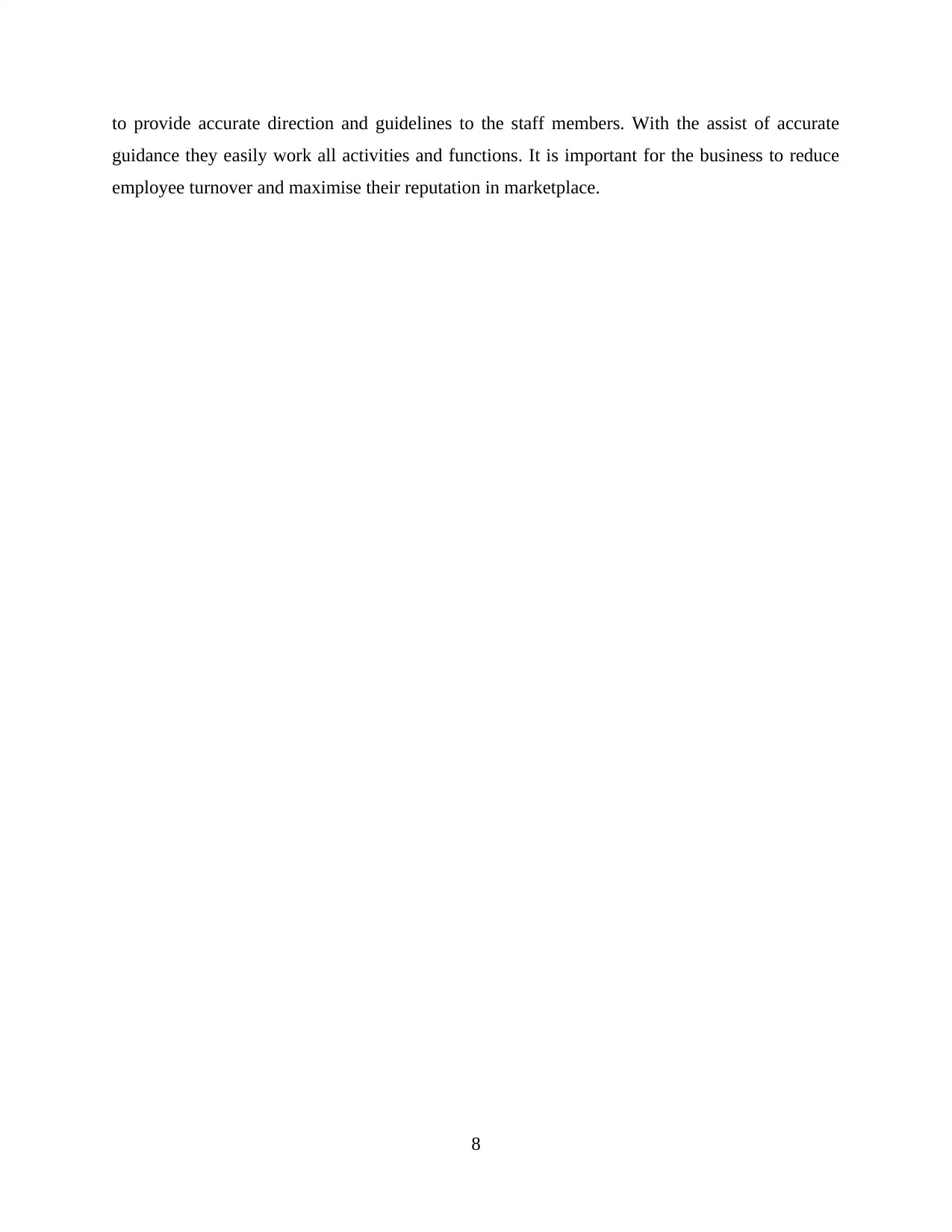
to provide accurate direction and guidelines to the staff members. With the assist of accurate
guidance they easily work all activities and functions. It is important for the business to reduce
employee turnover and maximise their reputation in marketplace.
8
guidance they easily work all activities and functions. It is important for the business to reduce
employee turnover and maximise their reputation in marketplace.
8
Paraphrase This Document
Need a fresh take? Get an instant paraphrase of this document with our AI Paraphraser
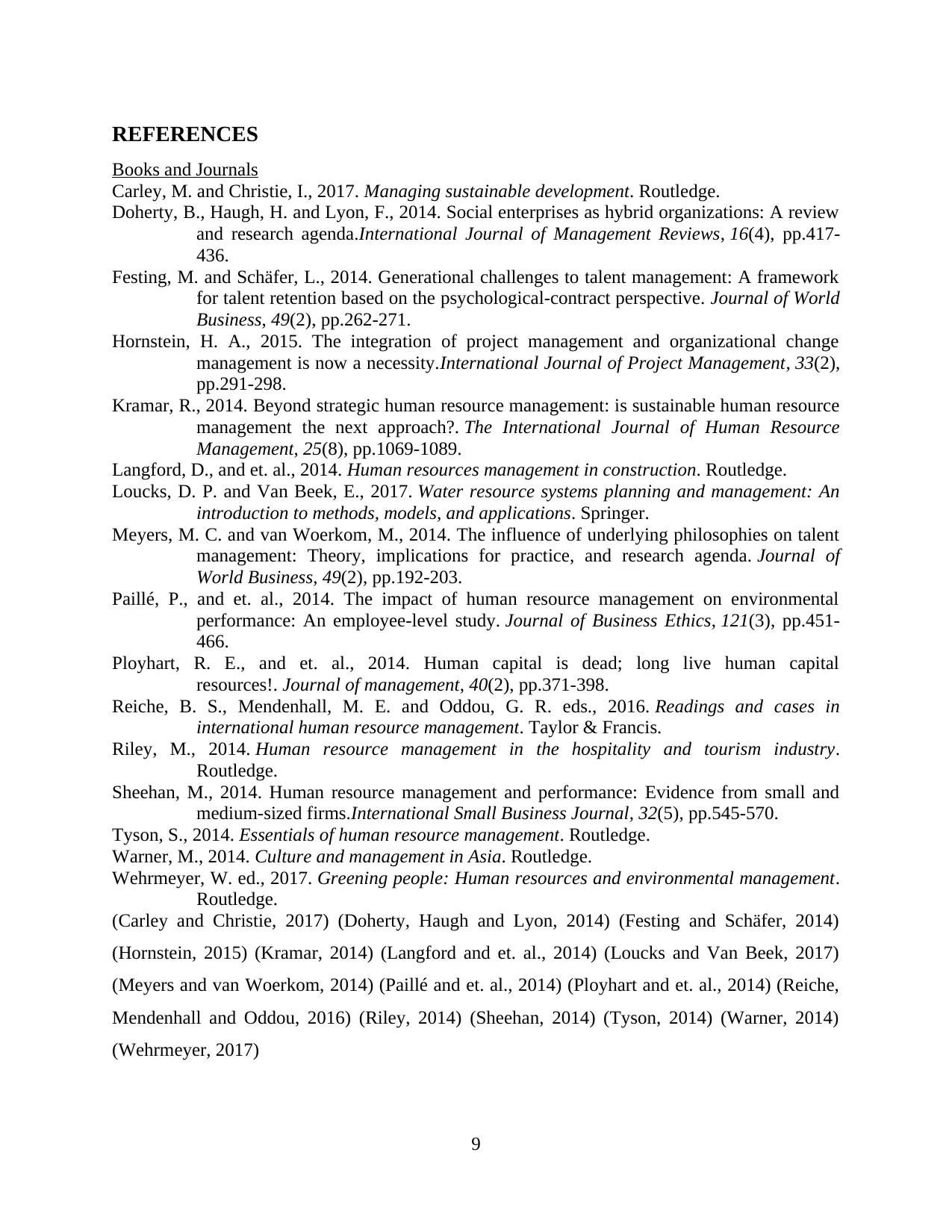
REFERENCES
Books and Journals
Carley, M. and Christie, I., 2017. Managing sustainable development. Routledge.
Doherty, B., Haugh, H. and Lyon, F., 2014. Social enterprises as hybrid organizations: A review
and research agenda.International Journal of Management Reviews, 16(4), pp.417-
436.
Festing, M. and Schäfer, L., 2014. Generational challenges to talent management: A framework
for talent retention based on the psychological-contract perspective. Journal of World
Business, 49(2), pp.262-271.
Hornstein, H. A., 2015. The integration of project management and organizational change
management is now a necessity.International Journal of Project Management, 33(2),
pp.291-298.
Kramar, R., 2014. Beyond strategic human resource management: is sustainable human resource
management the next approach?. The International Journal of Human Resource
Management, 25(8), pp.1069-1089.
Langford, D., and et. al., 2014. Human resources management in construction. Routledge.
Loucks, D. P. and Van Beek, E., 2017. Water resource systems planning and management: An
introduction to methods, models, and applications. Springer.
Meyers, M. C. and van Woerkom, M., 2014. The influence of underlying philosophies on talent
management: Theory, implications for practice, and research agenda. Journal of
World Business, 49(2), pp.192-203.
Paillé, P., and et. al., 2014. The impact of human resource management on environmental
performance: An employee-level study. Journal of Business Ethics, 121(3), pp.451-
466.
Ployhart, R. E., and et. al., 2014. Human capital is dead; long live human capital
resources!. Journal of management, 40(2), pp.371-398.
Reiche, B. S., Mendenhall, M. E. and Oddou, G. R. eds., 2016. Readings and cases in
international human resource management. Taylor & Francis.
Riley, M., 2014. Human resource management in the hospitality and tourism industry.
Routledge.
Sheehan, M., 2014. Human resource management and performance: Evidence from small and
medium-sized firms.International Small Business Journal, 32(5), pp.545-570.
Tyson, S., 2014. Essentials of human resource management. Routledge.
Warner, M., 2014. Culture and management in Asia. Routledge.
Wehrmeyer, W. ed., 2017. Greening people: Human resources and environmental management.
Routledge.
(Carley and Christie, 2017) (Doherty, Haugh and Lyon, 2014) (Festing and Schäfer, 2014)
(Hornstein, 2015) (Kramar, 2014) (Langford and et. al., 2014) (Loucks and Van Beek, 2017)
(Meyers and van Woerkom, 2014) (Paillé and et. al., 2014) (Ployhart and et. al., 2014) (Reiche,
Mendenhall and Oddou, 2016) (Riley, 2014) (Sheehan, 2014) (Tyson, 2014) (Warner, 2014)
(Wehrmeyer, 2017)
9
Books and Journals
Carley, M. and Christie, I., 2017. Managing sustainable development. Routledge.
Doherty, B., Haugh, H. and Lyon, F., 2014. Social enterprises as hybrid organizations: A review
and research agenda.International Journal of Management Reviews, 16(4), pp.417-
436.
Festing, M. and Schäfer, L., 2014. Generational challenges to talent management: A framework
for talent retention based on the psychological-contract perspective. Journal of World
Business, 49(2), pp.262-271.
Hornstein, H. A., 2015. The integration of project management and organizational change
management is now a necessity.International Journal of Project Management, 33(2),
pp.291-298.
Kramar, R., 2014. Beyond strategic human resource management: is sustainable human resource
management the next approach?. The International Journal of Human Resource
Management, 25(8), pp.1069-1089.
Langford, D., and et. al., 2014. Human resources management in construction. Routledge.
Loucks, D. P. and Van Beek, E., 2017. Water resource systems planning and management: An
introduction to methods, models, and applications. Springer.
Meyers, M. C. and van Woerkom, M., 2014. The influence of underlying philosophies on talent
management: Theory, implications for practice, and research agenda. Journal of
World Business, 49(2), pp.192-203.
Paillé, P., and et. al., 2014. The impact of human resource management on environmental
performance: An employee-level study. Journal of Business Ethics, 121(3), pp.451-
466.
Ployhart, R. E., and et. al., 2014. Human capital is dead; long live human capital
resources!. Journal of management, 40(2), pp.371-398.
Reiche, B. S., Mendenhall, M. E. and Oddou, G. R. eds., 2016. Readings and cases in
international human resource management. Taylor & Francis.
Riley, M., 2014. Human resource management in the hospitality and tourism industry.
Routledge.
Sheehan, M., 2014. Human resource management and performance: Evidence from small and
medium-sized firms.International Small Business Journal, 32(5), pp.545-570.
Tyson, S., 2014. Essentials of human resource management. Routledge.
Warner, M., 2014. Culture and management in Asia. Routledge.
Wehrmeyer, W. ed., 2017. Greening people: Human resources and environmental management.
Routledge.
(Carley and Christie, 2017) (Doherty, Haugh and Lyon, 2014) (Festing and Schäfer, 2014)
(Hornstein, 2015) (Kramar, 2014) (Langford and et. al., 2014) (Loucks and Van Beek, 2017)
(Meyers and van Woerkom, 2014) (Paillé and et. al., 2014) (Ployhart and et. al., 2014) (Reiche,
Mendenhall and Oddou, 2016) (Riley, 2014) (Sheehan, 2014) (Tyson, 2014) (Warner, 2014)
(Wehrmeyer, 2017)
9

10
⊘ This is a preview!⊘
Do you want full access?
Subscribe today to unlock all pages.

Trusted by 1+ million students worldwide
1 out of 12
Related Documents
Your All-in-One AI-Powered Toolkit for Academic Success.
+13062052269
info@desklib.com
Available 24*7 on WhatsApp / Email
![[object Object]](/_next/static/media/star-bottom.7253800d.svg)
Unlock your academic potential
Copyright © 2020–2025 A2Z Services. All Rights Reserved. Developed and managed by ZUCOL.





